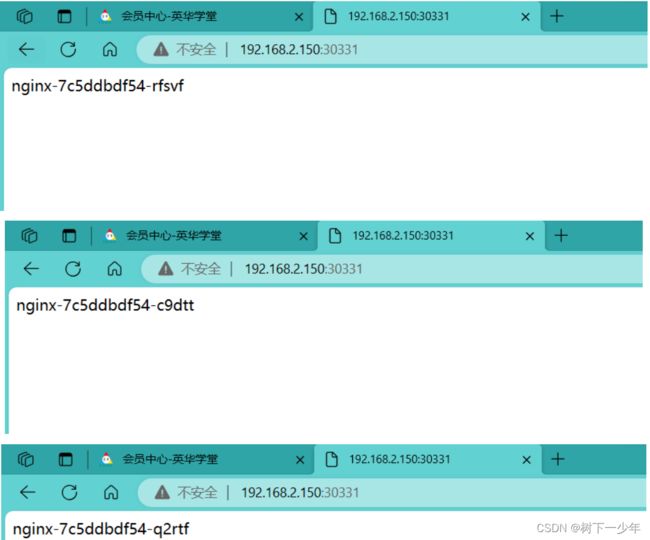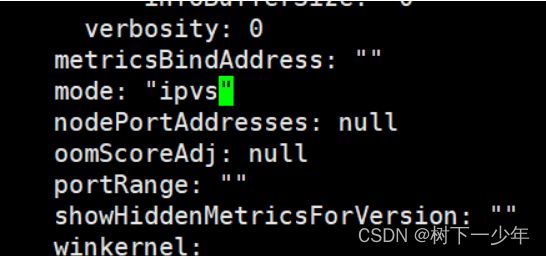k8s中label标签、deployment控制器、service、ipvs管理简介
目录
一.label管理
1.label的作用和特点
2.标签的查询和筛选
(1)等式型
(2)集合型
3.命令行打标签用法示例
(1)为资源对象添加多个标签
(2)更该原有标签
(3)删除标签
4.配置文件打标签用法示例
二.deployment控制器
1.pod控制器简介
2.deployment控制器
三.service管理
1.kubernetes内部可访问的service
2.kubernetes外部可访问的service
3.删除service
四.ipvs管理(做一次就行)
1.加载内核模块(通常在部署kubernetes环境时就已经做了)
2.edit修改kube-proxy配置
3.删除kube-proxy空间下的所有pod以重新添加生效
一.label管理
1.label的作用和特点
(1)label用来在资源上添加标识,来对资源进行区分选择
(2)label一般会以类似于键值对的形式打到资源上,如node、pod、service等对象,一个资源对象可以有多个标签,多个资源对象也可以打同一个标签
2.标签的查询和筛选
使用-l参数,需要指定资源类型(但不需要指定该资源的对象具体名称)、筛选条件,命名空间
(1)等式型
[root@k8s-master ~]# kubectl get pod -l port=80 --show-labels -n myns #筛选并输出myns下标签为port=80的pod
NAME READY STATUS RESTARTS AGE LABELS
nginx 1/1 Running 0 8m10s port=80,run=nginx,user=nginx
[root@k8s-master ~]# kubectl get pod -l port!=80 --show-labels -n myns #筛选并输出myns下标签不为port=80的pod
No resources found in myns namespace.(2)集合型
[root@k8s-master ~]# kubectl get pod -l 'user in (nginx,sulibao)' --show-labels -n myns
#筛选并输出myns下标签的user字段的值是nginx或sulibao的pod
NAME READY STATUS RESTARTS AGE LABELS
nginx 1/1 Running 0 32m port=80,run=nginx,user=nginx
[root@k8s-master ~]# kubectl get pod -l 'user notin (sulibao)' --show-labels -n myns
#筛选并输出myns下标签的user字段的值不是sulibao的pod
NAME READY STATUS RESTARTS AGE LABELS
nginx 1/1 Running 0 38m port=80,run=nginx,user=nginx3.命令行打标签用法示例
(1)为资源对象添加多个标签
[root@k8s-master ~]# kubectl get pod nginx -n myns --show-labels
NAME READY STATUS RESTARTS AGE LABELS
nginx 1/1 Running 0 85s run=nginx
[root@k8s-master ~]# kubectl label pod nginx port=80 -n myns
pod/nginx labeled
[root@k8s-master ~]# kubectl label pod nginx user=nginx -n myns
pod/nginx labeled
[root@k8s-master ~]# kubectl get pod nginx -n myns --show-labels
NAME READY STATUS RESTARTS AGE LABELS
nginx 1/1 Running 0 2m10s port=80,run=nginx,user=nginx(2)更该原有标签
[root@k8s-master ~]# kubectl label pod nginx user=sulibao -n myns --overwrite
pod/nginx labeled
[root@k8s-master ~]# kubectl get pod -n myns --show-labels
NAME READY STATUS RESTARTS AGE LABELS
nginx 1/1 Running 0 49m port=80,run=nginx,user=sulibao(3)删除标签
指定以“标签名-”格式来删除
[root@k8s-master ~]# kubectl label pod nginx port- -n myns
pod/nginx unlabeled
[root@k8s-master ~]# kubectl get pod -n myns --show-labels
NAME READY STATUS RESTARTS AGE LABELS
nginx 1/1 Running 0 51m run=nginx,user=sulibao4.配置文件打标签用法示例
(1)定义创建namespace和pod和label文件
[root@k8s-master ~]# cat nginxpod.yaml
apiVersion: v1
kind: Namespace
metadata:
name: myns
---
apiVersion: v1
kind: Pod
metadata:
name: nginxpod
namespace: myns
labels: #指定标签选项
version: "2.0" #标签内容
spec:
containers:
- name: nginx-containers
image: nginx(2)创建并验证
[root@k8s-master ~]# kubectl create -f nginxpod.yaml
namespace/myns created
pod/nginxpod created
[root@k8s-master ~]# kubectl get pods -n myns --show-labels
NAME READY STATUS RESTARTS AGE LABELS
nginxpod 1/1 Running 0 19s version=2.0二.deployment控制器
1.pod控制器简介
以往文章提到,kubernetes里pod是最小的控制单元,大部分情况下是通过pod控制器来操作pod的,pod控制器主要是在当pod故障时,进行重启或重新添加pod资源
2.deployment控制器
(1)命令行常用参数
| 参数 | 功能 |
|---|---|
| --image | 指定镜像 |
| --port | 指定端口 |
| --namespace | 指定命名空间 |
| --replicas | 指定pod的期望数量,指定后再某个pod出现故障退出控制后会自动添加pod数量至该参数指定的数量,在1.18版本后--replicas用于kubectl create命令而不存在于kubectl run的使用范围 |
(2)deployment控制器管理pod资源示例
#命令行管理
[root@k8s-master ~]# kubectl create deployment nginx --image=nginx --port=80 --replicas=3 -n myns
deployment.apps/nginx created
[root@k8s-master ~]# kubectl get pods -n myns
NAME READY STATUS RESTARTS AGE
nginx-7c5ddbdf54-h65ch 1/1 Running 0 15s
nginx-7c5ddbdf54-ktmj9 1/1 Running 0 15s
nginx-7c5ddbdf54-vpm8n 1/1 Running 0 15s
[root@k8s-master ~]# kubectl get deploy -n myns #查看deployment信息
NAME READY UP-TO-DATE AVAILABLE AGE
nginx 3/3 3 3 29s
#UP-TO-DATE表示成功成绩的副本数,AVAILABLE表示可用的副本数
[root@k8s-master ~]# kubectl delete pod nginx-7c5ddbdf54-h65ch -n myns #删除一个pod资源
pod "nginx-7c5ddbdf54-h65ch" deleted
[root@k8s-master ~]# kubectl get pods -n myns
#由于我们指定了replicas=3,所以即使我们删除了一个pod,也会自动新增一个新的pod以达到我们的指定的期望pod数量
NAME READY STATUS RESTARTS AGE
nginx-7c5ddbdf54-9zf2k 1/1 Running 0 8s
nginx-7c5ddbdf54-ktmj9 1/1 Running 0 104s
nginx-7c5ddbdf54-vpm8n 1/1 Running 0 104s
[root@k8s-master ~]# kubectl get pods -n myns -o wide
#新增的pod的name和IP都会发生改变,这个IP也是虚拟IP,外部无法直接访问
NAME READY STATUS RESTARTS AGE IP NODE NOMINATED NODE READINESS GATES
nginx-7c5ddbdf54-c9dtt 1/1 Running 0 2m2s 10.244.169.133 k8s-node2
nginx-7c5ddbdf54-q2rtf 1/1 Running 0 2m2s 10.244.169.132 k8s-node2
nginx-7c5ddbdf54-rfsvf 1/1 Running 0 2m2s 10.244.36.68 k8s-node1
[root@k8s-master ~]# kubectl delete deploy nginx -n myns #删除整个资源
deployment.apps "nginx" deleted
#文件形式
[root@k8s-master ~]# kubectl create deployment nginx --image=nginx --port=80 --replicas=3 -n myns -o yaml
apiVersion: apps/v1
kind: Deployment
metadata:
creationTimestamp: "2023-10-30T11:27:49Z"
generation: 1
labels:
app: nginx
name: nginx
namespace: myns
resourceVersion: "4986"
uid: 1872c4fe-d168-4fb1-9721-f6edff5beab6
spec:
progressDeadlineSeconds: 600
replicas: 3
revisionHistoryLimit: 10
selector:
matchLabels:
app: nginx
strategy:
rollingUpdate:
maxSurge: 25%
maxUnavailable: 25%
type: RollingUpdate
template:
metadata:
creationTimestamp: null
labels:
app: nginx
spec:
containers:
- image: nginx
imagePullPolicy: Always
name: nginx
ports:
- containerPort: 80
protocol: TCP
resources: {}
terminationMessagePath: /dev/termination-log
terminationMessagePolicy: File
dnsPolicy: ClusterFirst
restartPolicy: Always
schedulerName: default-scheduler
securityContext: {}
terminationGracePeriodSeconds: 30
status: {}
[root@k8s-master ~]# kubectl get pods -n myns
NAME READY STATUS RESTARTS AGE
nginx-7c5ddbdf54-c9dtt 1/1 Running 0 15s
nginx-7c5ddbdf54-q2rtf 1/1 Running 0 15s
nginx-7c5ddbdf54-rfsvf 1/1 Running 0 15s 三.service管理
此处主要简单介绍解决访问pod上nginx服务的问题,service也可以理解为pod们被访问的接口,也可以通过service实现负载均衡
1.kubernetes内部可访问的service
(1)简单示例
[root@k8s-master ~]# kubectl expose deployment nginx --name=service-nginx --type=ClusterIP --port=80 --target-port=80 -n myns
#指定暴露nginx,service名称为service-nginx,类型为ClusterIP(只有集群内部能通信的类型),暴露端口,名称空间
service/service-nginx exposed
[root@k8s-master ~]# kubectl get service service-nginx -n myns -o wide
NAME TYPE CLUSTER-IP EXTERNAL-IP PORT(S) AGE SELECTOR
service-nginx ClusterIP 10.109.112.194 80/TCP 36s app=nginx
[root@k8s-master ~]# curl 10.109.112.194 #访问的是clusterip,这个ip在service工作期间通常是不会变的
Welcome to nginx!
Welcome to nginx!
If you see this page, the nginx web server is successfully installed and
working. Further configuration is required.
For online documentation and support please refer to
nginx.org.
Commercial support is available at
nginx.com.
Thank you for using nginx.
(2)简单负载均衡实现
[root@k8s-master ~]# kubectl get pods -n myns -o wide
NAME READY STATUS RESTARTS AGE IP NODE NOMINATED NODE READINESS GATES
nginx-7c5ddbdf54-c9dtt 1/1 Running 0 22m 10.244.169.133 k8s-node2
nginx-7c5ddbdf54-q2rtf 1/1 Running 0 22m 10.244.169.132 k8s-node2
nginx-7c5ddbdf54-rfsvf 1/1 Running 0 22m 10.244.36.68 k8s-node1
[root@k8s-master ~]# kubectl exec nginx-7c5ddbdf54-c9dtt -it -n myns -- /bin/bash #对于pod的进一步操作后几篇文章作介绍和演示
root@nginx-7c5ddbdf54-c9dtt:/# echo `hostname` > /usr/share/nginx/html/index.html
root@nginx-7c5ddbdf54-c9dtt:/# exit
exit
[root@k8s-master ~]# kubectl exec nginx-7c5ddbdf54-q2rtf -it -n myns -- /bin/bash
root@nginx-7c5ddbdf54-q2rtf:/# echo `hostname` > /usr/share/nginx/html/index.html
root@nginx-7c5ddbdf54-q2rtf:/# exit
exit
[root@k8s-master ~]# kubectl exec nginx-7c5ddbdf54-rfsvf -it -n myns -- /bin/bash
root@nginx-7c5ddbdf54-rfsvf:/# echo `hostname` > /usr/share/nginx/html/index.html
root@nginx-7c5ddbdf54-rfsvf:/# exit
exit
[root@k8s-master ~]# curl 10.109.112.194
nginx-7c5ddbdf54-c9dtt
[root@k8s-master ~]# curl 10.109.112.194
nginx-7c5ddbdf54-q2rtf
[root@k8s-master ~]# curl 10.109.112.194
nginx-7c5ddbdf54-q2rtf
[root@k8s-master ~]# curl 10.109.112.194
nginx-7c5ddbdf54-q2rtf
[root@k8s-master ~]# curl 10.109.112.194
nginx-7c5ddbdf54-rfsvf
[root@k8s-master ~]# curl 10.109.112.194
nginx-7c5ddbdf54-rfsvf 2.kubernetes外部可访问的service
(1)按照上面的步骤就只需要将type改为NodePort即可
[root@k8s-master ~]# kubectl expose deployment nginx --name=service-nginx1 --type=NodePort --port=80 --target-port=80 -n myns
service/service-nginx1 exposed
[root@k8s-master ~]# kubectl get service service-nginx1 -n myns -o wide
NAME TYPE CLUSTER-IP EXTERNAL-IP PORT(S) AGE SELECTOR
service-nginx1 NodePort 10.110.248.180 80:30331/TCP 19s app=nginx (2)在主机和浏览器都可以访问,同样可以实现负载均衡
注意:是使用主机(虚拟机地址)+service暴露的端口(示例暴露的是30331端口)进行访问
[root@k8s-master ~]# curl 192.168.2.150:30331
nginx-7c5ddbdf54-q2rtf
[root@k8s-master ~]# curl 192.168.2.150:30331
nginx-7c5ddbdf54-c9dtt
[root@k8s-master ~]# curl 192.168.2.150:30331
nginx-7c5ddbdf54-rfsvf3.删除service
[root@k8s-master ~]# kubectl delete service service-nginx -n myns四.ipvs管理(做一次就行)
使用ipvs去替换iptables以支持更复杂的调度算法、健康检查等,提高管理运行效率
1.加载内核模块(通常在部署kubernetes环境时就已经做了)
[root@k8s-master ~]# lsmod | grep ip_vs
ip_vs_sh 12688 0
ip_vs_wrr 12697 0
ip_vs_rr 12600 0
ip_vs 145458 6 ip_vs_rr,ip_vs_sh,ip_vs_wrr
nf_conntrack 139264 10 ip_vs,nf_nat,nf_nat_ipv4,nf_nat_ipv6,xt_conntrack,nf_nat_masquerade_ipv4,nf_nat_masquerade_ipv6,nf_conntrack_netlink,nf_conntrack_ipv4,nf_conntrack_ipv6
libcrc32c 12644 4 xfs,ip_vs,nf_nat,nf_conntrack2.edit修改kube-proxy配置
[root@k8s-master ~]# kubectl edit configmap kube-proxy -n kube-system
configmap/kube-proxy edited
#将mode改为ipvs3.删除kube-proxy空间下的所有pod以重新添加生效
(1)删除
[root@k8s-master ~]# kubectl get pods -n kube-system | grep kube-proxy
kube-proxy-tk2m4 1/1 Running 0 99m
kube-proxy-w4nbw 1/1 Running 0 98m
kube-proxy-x7z2w 1/1 Running 0 98m
[root@k8s-master ~]# kubectl delete pod kube-proxy-tk2m4 kube-proxy-w4nbw kube-proxy-x7z2w -n kube-system
pod "kube-proxy-tk2m4" deleted
pod "kube-proxy-w4nbw" deleted
pod "kube-proxy-x7z2w" deleted(2)验证
#名称已发生变化,新pod已添加成功
[root@k8s-master ~]# kubectl get pods -n kube-system | grep kube-proxy
kube-proxy-6xlff 1/1 Running 0 16s
kube-proxy-k5fm7 1/1 Running 0 16s
kube-proxy-sqzxf 1/1 Running 0 16s
#查看日志时已经使用ipvs进行代理
[root@k8s-master ~]# kubectl logs kube-proxy-6xlff -n kube-system | grep ipvsI1030 12:24:48.489664 1 server_others.go:218] "Using ipvs Proxier"
#已生效
[root@k8s-master ~]# ipvsadm -Ln
IP Virtual Server version 1.2.1 (size=4096)
Prot LocalAddress:Port Scheduler Flags
-> RemoteAddress:Port Forward Weight ActiveConn InActConn
TCP 192.168.2.150:30331 rr
-> 10.244.36.68:80 Masq 1 0 0
-> 10.244.169.132:80 Masq 1 0 0
-> 10.244.169.133:80 Masq 1 0 0
TCP 10.96.0.1:443 rr
-> 192.168.2.150:6443 Masq 1 1 0
TCP 10.96.0.10:53 rr
-> 10.244.235.193:53 Masq 1 0 0
-> 10.244.235.195:53 Masq 1 0 0
TCP 10.96.0.10:9153 rr
-> 10.244.235.193:9153 Masq 1 0 0
-> 10.244.235.195:9153 Masq 1 0 0
TCP 10.109.112.194:80 rr
-> 10.244.36.68:80 Masq 1 0 0
-> 10.244.169.132:80 Masq 1 0 0
-> 10.244.169.133:80 Masq 1 0 0
TCP 10.110.248.180:80 rr
-> 10.244.36.68:80 Masq 1 0 0
-> 10.244.169.132:80 Masq 1 0 0
-> 10.244.169.133:80 Masq 1 0 0
TCP 10.244.235.192:30331 rr
-> 10.244.36.68:80 Masq 1 0 0
-> 10.244.169.132:80 Masq 1 0 0
-> 10.244.169.133:80 Masq 1 0 0
UDP 10.96.0.10:53 rr
-> 10.244.235.193:53 Masq 1 0 0
-> 10.244.235.195:53 Masq 1 0 0 
